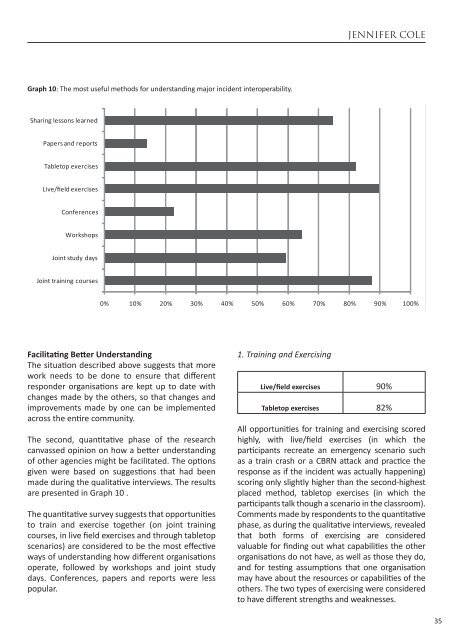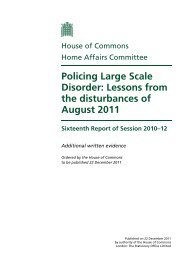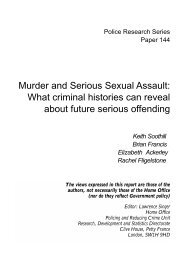INTEROPERABILITY IN A CRISIS 2 - RUSI
INTEROPERABILITY IN A CRISIS 2 - RUSI
INTEROPERABILITY IN A CRISIS 2 - RUSI
Create successful ePaper yourself
Turn your PDF publications into a flip-book with our unique Google optimized e-Paper software.
Graph 10: The most useful methods for understanding major incident interoperability.<br />
Sharing lessons learned<br />
Papers and reports<br />
Tabletop exercises<br />
Live/field exercises<br />
Conferences<br />
Workshops<br />
Joint study days<br />
Joint training courses<br />
<strong>IN</strong>sERT gRAPh 9.9 hERE<br />
Facilitating Better Understanding<br />
The situation described above suggests that more<br />
work needs to be done to ensure that different<br />
responder organisations are kept up to date with<br />
changes made by the others, so that changes and<br />
improvements made by one can be implemented<br />
across the entire community.<br />
The second, quantitative phase of the research<br />
canvassed opinion on how a better understanding<br />
of other agencies might be facilitated. The options<br />
given were based on suggestions that had been<br />
made during the qualitative interviews. The results<br />
are presented in Graph 10 .<br />
The quantitative survey suggests that opportunities<br />
to train and exercise together (on joint training<br />
courses, in live field exercises and through tabletop<br />
scenarios) are considered to be the most effective<br />
ways of understanding how different organisations<br />
operate, followed by workshops and joint study<br />
days. Conferences, papers and reports were less<br />
popular.<br />
1. Training and Exercising<br />
jENNIFER COLE<br />
0% 10% 20% 30% 40% 50% 60% 70% 80% 90% 100%<br />
Live/field exercises 90%<br />
Tabletop exercises 82%<br />
All opportunities for training and exercising scored<br />
highly, with live/field exercises (in which the<br />
participants recreate an emergency scenario such<br />
as a train crash or a CBRN attack and practice the<br />
response as if the incident was actually happening)<br />
scoring only slightly higher than the second-highest<br />
placed method, tabletop exercises (in which the<br />
participants talk though a scenario in the classroom).<br />
Comments made by respondents to the quantitative<br />
phase, as during the qualitative interviews, revealed<br />
that both forms of exercising are considered<br />
valuable for finding out what capabilities the other<br />
organisations do not have, as well as those they do,<br />
and for testing assumptions that one organisation<br />
may have about the resources or capabilities of the<br />
others. The two types of exercising were considered<br />
to have different strengths and weaknesses.<br />
35

















